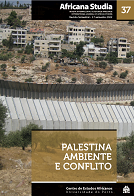Land use changes and spatial analysis of an urban development case study: Shu’fat camp area of Jerusalem
Abstract
This study discusses the changes on land-use between 1997 and 2019 in the Shu’fat refugee camp area, one of the most populous and dense areas under a complex geopolitical dilemma in northeast Jerusalem. This paper aims to find the main demographic and spatiotemporal transformations that accompanied the process of urban development in the Shu’fat refugees camp area. The analysis method is based on two aerial photos - 1997 and 2019 - which using GIS (Arcmap 10.5 software) detect land-use changes and the urban development of the area. The study area experienced an intense urban sprawl due to the high population growth after 2005, which is strongly connected to the building of the separation Wall by the Israelis. This resulted in a yearly pace of urban development of about 72.6 % by increasing the built-up area surface of bare land. Furthermore, the change of the characteristics of the natural landscape, such as forest area, is another significant result.
Important socioeconomic transformations from rural landscapes to condensed urban-look are evident.
Keywords: Land use, urban development, natural landscape, Shu’fat Camp.
Downloads
Downloads
Published
How to Cite
Issue
Section
License
Copyright (c) 2022 Africana Studia

This work is licensed under a Creative Commons Attribution-NonCommercial 4.0 International License.
Copyrights of all published material belong to Africana Studia.
Original images supplied by authors will be returned to them if requested


